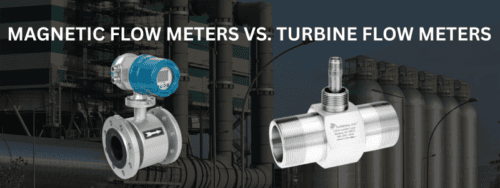Choosing the right flow meter can make a significant impact on process efficiency, accuracy, and long-term maintenance. Two of the most common types used across industries are magnetic flow meters and turbine flow meters. While each has its own strengths and limitations, understanding the differences between them can help ensure you’re selecting the best technology for your specific application.
How They Work
Magnetic Flow Meters
Magnetic flow meters, also known as mag meters, operate on Faraday’s Law of Electromagnetic Induction. When a conductive liquid flows through a magnetic field generated by the meter, it induces a voltage. This voltage is directly proportional to the flow velocity of the fluid. Electrodes in the meter pick up the voltage signal, which is then converted to a flow rate.
Because of their operating principle, magnetic flow meters can only measure electrically conductive fluids—typically those with a conductivity of at least 5 µS/cm. This includes water-based liquids, slurries, acids, and certain chemical solutions.
Turbine Flow Meters
Turbine flow meters measure flow by tracking the mechanical rotation of a turbine or rotor placed within the fluid stream. As the fluid moves through the meter, it causes the rotor to spin. The rotational speed is directly proportional to the flow rate. Sensors detect the number of rotations and convert it into volumetric flow.
Turbine meters can measure a wide variety of clean, low-viscosity fluids regardless of electrical conductivity. This makes them suitable for hydrocarbons, fuels, oils, and even cryogenic liquids.
Key Difference: Conductivity Requirements
One of the most critical distinctions between these technologies is the type of fluid they can measure. Magnetic flow meters cannot measure non-conductive liquids, such as pure hydrocarbons, oils, or deionized water. These fluids do not generate a measurable voltage as they pass through the magnetic field, rendering the mag meter inoperable.
In contrast, turbine flow meters are entirely mechanical and do not depend on a fluid’s conductivity. This makes them more versatile in applications involving non-conductive or low-conductivity liquids.
Accuracy and Repeatability
Magnetic Flow Meters
Mag meters typically provide high accuracy and excellent repeatability, especially in full pipe applications with steady flow. Their accuracy is generally within ±0.2% to ±0.5% of reading, depending on the manufacturer and model.
Because they have no moving parts, their measurements are not affected by mechanical wear, and they maintain long-term accuracy with minimal drift.
Turbine Flow Meters
Turbine flow meters are also known for good accuracy, often in the range of ±0.5% to ±1% of reading. However, accuracy can degrade over time due to wear and tear on the moving parts, especially in applications with abrasive fluids or inconsistent flow conditions.
Proper installation, alignment, and regular calibration are key to maintaining turbine meter accuracy.
Maintenance and Durability
Magnetic Flow Meters
One of the biggest advantages of magnetic flow meters is their lack of moving parts. This makes them less susceptible to mechanical failure, clogging, or wear from abrasive media. They are generally low-maintenance and well-suited for dirty or corrosive fluids, such as wastewater or slurries.
However, mag meters do require a full pipe for accurate readings, and buildup on electrodes in high-solids environments may require occasional cleaning.
Turbine Flow Meters
Turbine meters do have moving parts—most notably the rotor—which makes them more prone to wear in applications with particulates or corrosive materials. They are best used in clean liquid services where maintenance intervals can be reliably scheduled.
That said, turbine meters are rugged and can offer long service life in the right conditions, particularly in fuel transfer and custody transfer applications where cleanliness and consistent operating parameters are standard.
Pressure Drop and Flow Range
Magnetic Flow Meters
Because mag meters do not obstruct the flow path significantly and have no moving parts, they introduce minimal pressure drop. This makes them ideal for applications where maintaining line pressure is important.
They also perform well at both low and high flow rates, and they handle bidirectional flow with ease.
Turbine Flow Meters
Turbine meters can introduce a higher pressure drop compared to mag meters due to their internal components. However, they excel in high flow rate applications and provide fast response times.
They are generally less effective at very low flow rates, where rotor movement may become erratic or stop altogether.
Cost Considerations
In general, magnetic flow meters tend to have higher upfront costs due to their electronics and specialized liners. However, their low maintenance and long service life can offset these costs over time, especially in challenging fluid conditions.
Turbine flow meters are often more affordable upfront, especially for small to medium pipe sizes. But the need for occasional recalibration, bearing replacement, and sensitivity to fluid quality can increase lifecycle costs in some cases.
Conclusion
Both magnetic flow meters and turbine flow meters are proven technologies with strong track records in industrial flow measurement. The right choice depends heavily on your specific application requirements.
Choose a magnetic flow meter if:
- You’re measuring conductive liquids like water, acids, or slurries.
- You need low-maintenance operation and minimal pressure drop.
- You’re working with corrosive or dirty fluids.
Choose a turbine flow meter if:
- You’re measuring non-conductive fluids like oil, fuel, or cryogenic liquids.
- You require high accuracy in clean, low-viscosity applications.
- You’re in custody transfer or fuel dispensing operations.
Understanding the strengths and limitations of each type ensures optimal performance, cost-efficiency, and reliability. Ultimately, your process conditions should guide the decision—there is no one-size-fits-all solution.
